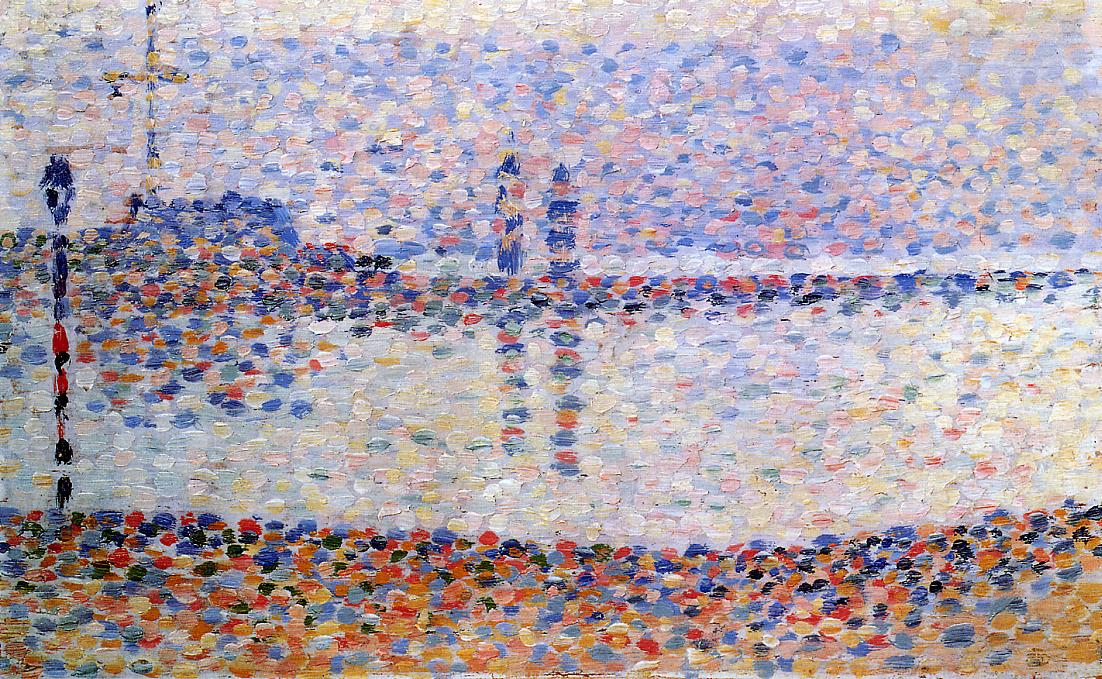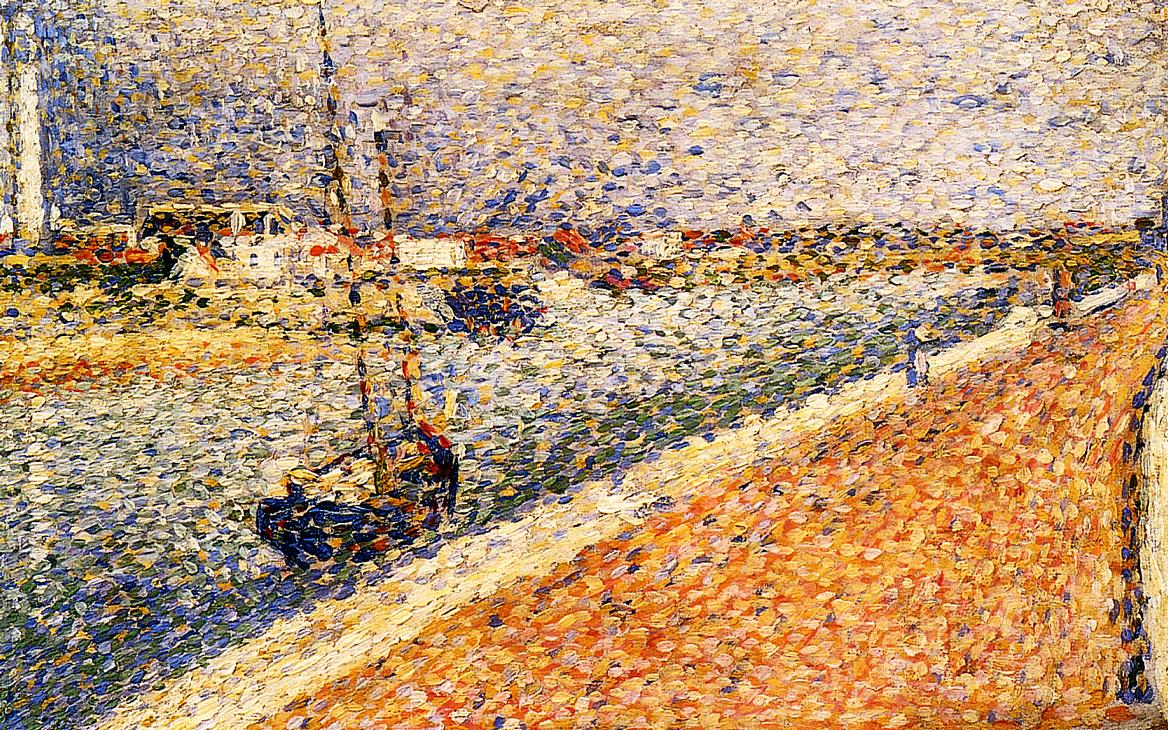In relation to the genres that I'm referencing as a major inspiration in my project, the author of "The shock of the new"- Robert Hughes, mentions both of the genres. And he also specifies, narrows down the biggest types of art that appeared during the 'art revolution' that took place late 19th- early 20th century.
He outlines a trend of producing art inspired by architecture and mechanisms that appeared in the age of innovations. The erection of Eiffel Tower, for example, supported by major shock, aspired so many new creations throughout the world, but especially in France.
Another widely-spread trend was to make art a medium for political situation and artist's personal opinion towards it- posters, illustrations and paintings that held all kinds of ideas (mainly not supporting the political scene) within them.
Different kinds of series of photography and painting were inspired by the ideals and their subjectivity- artists portrayed architecture and buildings of the new time- they were minimalistic or industrial or completely avant-garde, but that was an inspiration by the idea of one's utopia.
Other chapters dedicated to other movements seem more relevant.
For example:
1) "The Landscape of Pleasure"
"One of the projects of art is to reconcile us with the world, not by protest, irony, or political metaphors, but by the ecstatic contemplation of pleasure in nature. Repeatedly, artists offer us a glimpse of a universe into which we can move without strain. It is not the world as it is, but as our starved senses desire to be: neither hostile nor indifferent, but full of meaning- the terrestrial paradise whose gate was not opened by the mere fact of birth." (page112)
>Same I can tell about the way I edited my film: I tried to keep it real, with a story's narration being held throughout the length of the film, but with the projections, effects, cuts I hoped to open a new meaning of a 'sign' with a 'signifier', and unveil, show the 'signified' itself a bit clearer, or at least provoke the viewer's mind to 'work' towards reaching the understanding of the 'signified'.
He shows the examples of such paintings where the reality is not portrayed realistically, although not deformed or encoded through abstract objects..
Speaking of landscapes, I wanted to make the water look electric, distort the natural environment..
2) The threshold of Liberty
This chapter is about surrealism.
"Chance, memory, desire, coincidence would meet in new reality- a sur- reality" (page 213)
"The dream was instrument for this. It was the gate to art. In dreams, the id spoke; the dreaming mind was not legislated truth, and so was neurosis , the permanent involuntary form of dreams." (page 213)
It has always been connectd to the ideas proposed by Freud, however the first surrealists didn't know much of Freud's theory due to a lack of knowledge of German language.
However, I didn't use double-reading in my work, there was a game of symbols rather.
3) Thew View From the Edge
The author references Van Gogh's works mainly as those are inspired by nature and its' power, "Nature was to him both exquisite and terrible. It consoled him, but it was his judge." (273)
Author would point out not only the landscapes painting but even his own self-portrait that has got the "background of ice-blue whorls".
So that was like the aura of nature and its' haunting spirit. "It was the fingerprint of God", "the disc of the sun, huge and searching, the emblem of merciless Apollo".
I find it important as I use the nature as the clear side of the feeling I explore and through certain scenes I want to make it clear that I use these scenes for a reason, as the natural sights hold a deep meaning behind them, that is why I attempted to use a lot of it. I wanted to show its' mighty spirit and in my film it means something metaphysical.
And therefore, it is relevant to say there were artists like Paul Klee and Wassily Kandisky, who both were into the idea of Transcendentalism. And their works were showing their obsession with metaphysics clearly.
book details: Robert Hughes "The shock of the New" Thames and Hudson, London 1991
He outlines a trend of producing art inspired by architecture and mechanisms that appeared in the age of innovations. The erection of Eiffel Tower, for example, supported by major shock, aspired so many new creations throughout the world, but especially in France.
Another widely-spread trend was to make art a medium for political situation and artist's personal opinion towards it- posters, illustrations and paintings that held all kinds of ideas (mainly not supporting the political scene) within them.
Different kinds of series of photography and painting were inspired by the ideals and their subjectivity- artists portrayed architecture and buildings of the new time- they were minimalistic or industrial or completely avant-garde, but that was an inspiration by the idea of one's utopia.
Other chapters dedicated to other movements seem more relevant.
For example:
1) "The Landscape of Pleasure"
"One of the projects of art is to reconcile us with the world, not by protest, irony, or political metaphors, but by the ecstatic contemplation of pleasure in nature. Repeatedly, artists offer us a glimpse of a universe into which we can move without strain. It is not the world as it is, but as our starved senses desire to be: neither hostile nor indifferent, but full of meaning- the terrestrial paradise whose gate was not opened by the mere fact of birth." (page112)
>Same I can tell about the way I edited my film: I tried to keep it real, with a story's narration being held throughout the length of the film, but with the projections, effects, cuts I hoped to open a new meaning of a 'sign' with a 'signifier', and unveil, show the 'signified' itself a bit clearer, or at least provoke the viewer's mind to 'work' towards reaching the understanding of the 'signified'.
He shows the examples of such paintings where the reality is not portrayed realistically, although not deformed or encoded through abstract objects..
Georges Seurat
Claude Monet
Speaking of landscapes, I wanted to make the water look electric, distort the natural environment..
(from Illness film by Anya Oderyakova)
(from Illness film by Anya Oderyakova)
2) The threshold of Liberty
This chapter is about surrealism.
"Chance, memory, desire, coincidence would meet in new reality- a sur- reality" (page 213)
"The dream was instrument for this. It was the gate to art. In dreams, the id spoke; the dreaming mind was not legislated truth, and so was neurosis , the permanent involuntary form of dreams." (page 213)
It has always been connectd to the ideas proposed by Freud, however the first surrealists didn't know much of Freud's theory due to a lack of knowledge of German language.
However, I didn't use double-reading in my work, there was a game of symbols rather.
3) Thew View From the Edge
The author references Van Gogh's works mainly as those are inspired by nature and its' power, "Nature was to him both exquisite and terrible. It consoled him, but it was his judge." (273)
Author would point out not only the landscapes painting but even his own self-portrait that has got the "background of ice-blue whorls".
So that was like the aura of nature and its' haunting spirit. "It was the fingerprint of God", "the disc of the sun, huge and searching, the emblem of merciless Apollo".
I find it important as I use the nature as the clear side of the feeling I explore and through certain scenes I want to make it clear that I use these scenes for a reason, as the natural sights hold a deep meaning behind them, that is why I attempted to use a lot of it. I wanted to show its' mighty spirit and in my film it means something metaphysical.
And therefore, it is relevant to say there were artists like Paul Klee and Wassily Kandisky, who both were into the idea of Transcendentalism. And their works were showing their obsession with metaphysics clearly.
Paul Klee "Fugue in Red"
Illness project by Anya Oderyakova
4) CULTURE AS NATURE
This chapter is about the mass-media, advertisement, popular culture and how it naturally invaded art.
"From television, film and photography we receive a stream of images every day.... The extension, on the human level, for this gut of images is celebrity, which replaces the Renaissance idea of fame." (page 346)
Robert Rauschenberg
Andy Warhol
In my film, however hard I tried to avoid kitsch, at one point I reckoned it was quite a nice fit, playing with the idea of something so down-to-Earth, so 'machine'ry, it's a little toy I used as a frame to butchery work scene.
that little toy was the biggest Soviet electronic toy-device called "Oh, just wait!" (it's based on a cartoon where wolf ends up failing to catch and eat a rabbit, and every time he finds himself defeated he threatens saying "Oh, just wait!")
I found even that catching-phrase quite ironic to the scene,
We used it as a trick when the main character has her heart broken, illustrated through the next scene- this toy as a frame + a butcher cutting meat on its' screen.
from Illness project by Anya Oderyakova
book details: Robert Hughes "The shock of the New" Thames and Hudson, London 1991














No comments:
Post a Comment